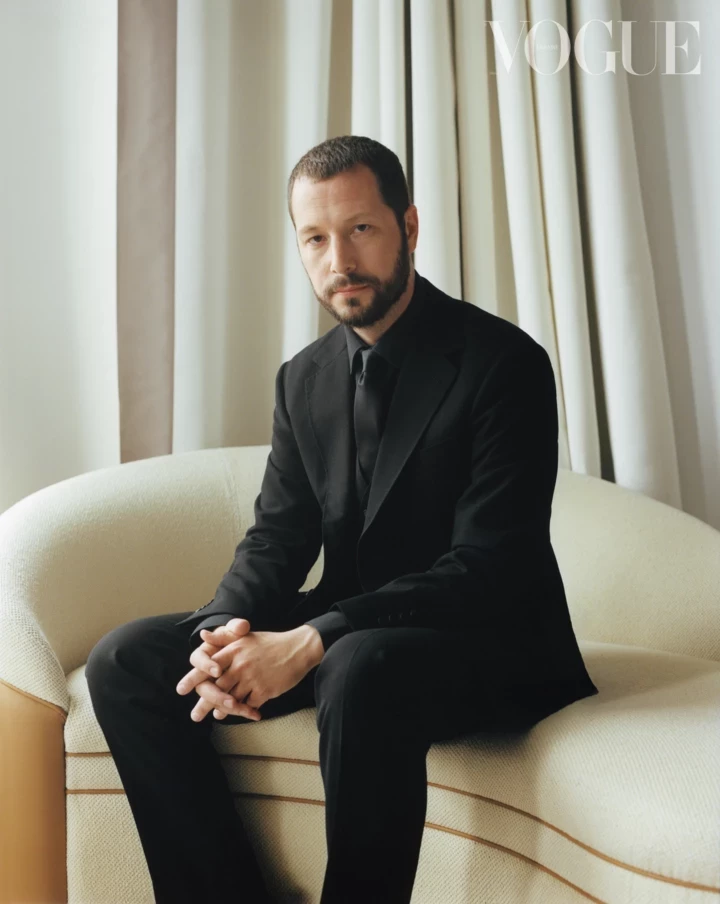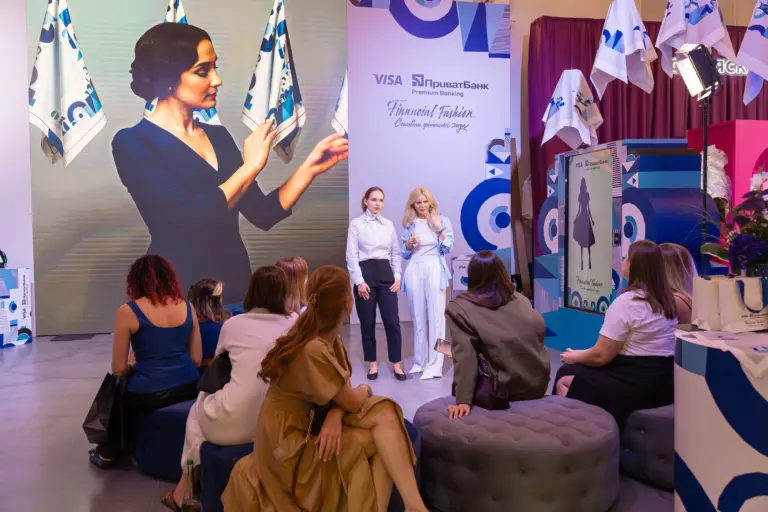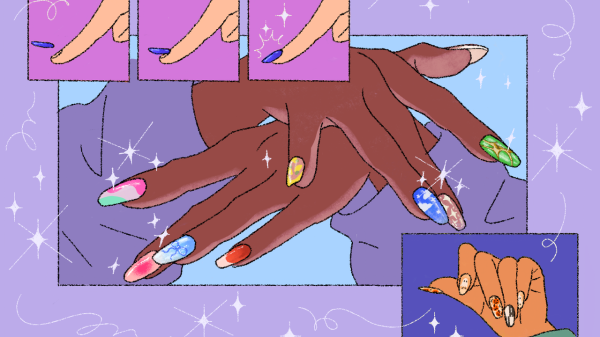
Save this storySave this storySave this storySave this storyYou’re reading the Goings On newsletter, a guide to what we’re watching, listening to, and doing this week. Sign up to receive it in your in-box.
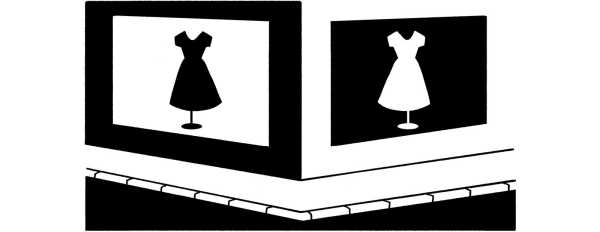
On and Off the Avenue
Rachel Syme surveys the press-on-nail renaissance.
For a little under a year, in 1987-88, Dolly Parton had her own variety show on ABC, called, fittingly, “Dolly.” The show lasted just twenty-two episodes, but it gave us one of the most charming encounters in pop-culture history (and one of my favorite clips circulating around the Internet): Parton and the singer Patti LaBelle sat together, in matching bespangled black dresses, and “played” their acrylic nails like percussion instruments. Parton demonstrated to LaBelle how she likes to strum one plastic-tipped hand across the other, creating the clacky sound of a washboard. LaBelle quickly joined in, and together they sang “Shortnin’ Bread,” accompanied only by their own manicures. Artificial talons have never produced something more authentically wonderful.
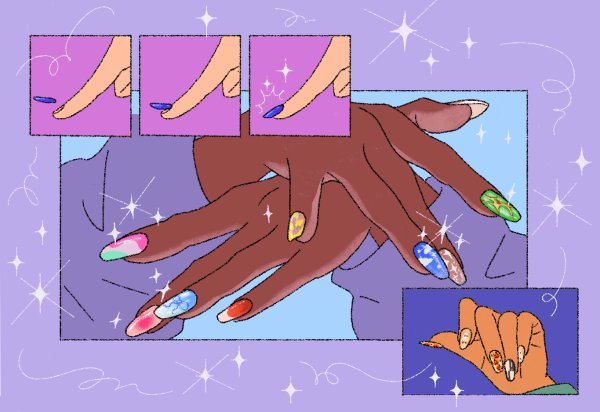
Illustration by Sarula Bao
The eighties were a big decade for acrylic nails, and particularly for “press-ons”—a set of gleamy prosthetic claws that people could apply in the comfort of their own homes, for far less than they might spend at a salon. The leading brand was Lee Press-ons, pioneered in California in the mid-seventies by a pharmaceutical executive named Henry Lee. A Washington Post reporter covered the phenomenon, writing that the boomlet was a harbinger of “the ’80s commitment to the art of self-maintenance.” When interviewed about the sudden demand for his signature product, Lee joked, “I’m afraid the FDA’s going to start calling them a drug.”
Nearly four decades later, press-ons are back in style—and arguably better than ever. We are, in fact, living through a new golden age of fake-nail technology. Glue-ables have come a long way since the flimsy supermarket tips I grew up with; the latest innovations are more durable, more fashionable, and (to echo Lee) even more addictive than their predecessors. There are near-countless styles, colors, shapes, and lengths available, ranging from fifteen to thirty dollars—my favorites come from Glamnetic (known for their festive seasonal “drops,” such as snow-flocked tips for winter), Chill House (an N.Y.C.-based spa that moved into the nail space in 2020 with “Chill Tips,” which come in de rigeur patterns like periwinkle checkerboard), Olive & June (whose “Instant Mani” sets are a breeze), Static (great for elegant basics, like beige and cherry red) and Rave Nailz, from the nail artist Braelinn Frank. (I’m partial to her “Rodeo French” style, a kicky spin on a French manicure in which the half-moons are saddle brown.) Even the longtime drugstore brand Kiss has stepped up its offerings. (The Olympic gymnast Suni Lee wore the brand’s newly released gel French tips when she competed in Paris this summer.) I usually apply my press-ons on the subway—it takes ten minutes, and it’s quite meditative—and with proper application, each set can last up to two weeks (though I keep a tube of nail glue with me, in case of any pop-offs). I like to think that Dolly would approve.
Spotlight
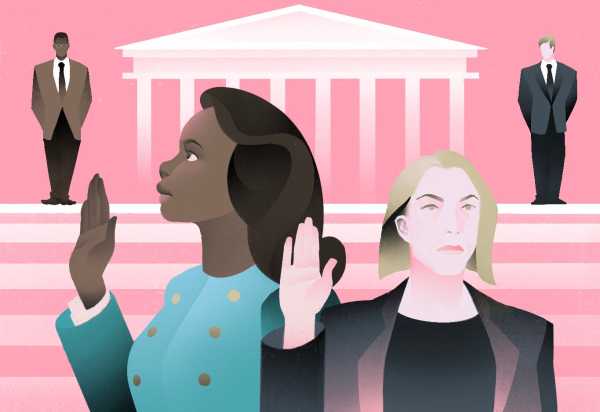
Illustration by Lia LiaoOff Broadway
During a Supreme Court Justice’s confirmation process, the prospective lifetime appointee undergoes a questioning period that has become increasingly theatrical. The theatre in question is, occasionally, Greek tragedy. In “The Ford/Hill Project,” Lee Sunday Evans stages two gripping, traumatic testimonies—Anita Hill’s revelations about harassment by Clarence Thomas and the sexual-assault accusations by Christine Blasey Ford against Brett Kavanaugh—by using verbatim text from their respective Senate hearings. Elizabeth Marvel co-conceived the event and plays Ford, with similarly stunning talents in other parts: Amber Iman, a Tony nominee for her work in “Lempicka,” plays Hill, and Dylan Baker and Eric Berryman give voice to the many men arrayed against them.—Helen Shaw (Public Theatre, Oct. 16-20.)

About Town
Indie Rock
Perhaps befitting a group of Irishmen who opened their pandemic breakthrough album, “A Hero’s Death,” with a song featuring the declarative couplet “I don’t belong to anyone / I don’t wanna belong to anyone,” the members of Fontaines D.C. have now shaken off some of the flinty post-punk roots that brought them renown far beyond their beloved Dublin City (that other D.C.). What’s surprising, however, is the degree to which “Romance,” the band’s new record, retains the essence of their lead vocalist Grian Chatten’s boldness while inviting in arena-ready melodic and production flourishes. It sounds like growth rather than transformation, which could explain why “Starburster,” their subtle wink at hip-hop, caught on as a summer single.—K. Leander Williams (Brooklyn Paramount; Oct. 15-16.)
Off Broadway
The musical adaptation of the 2012 movie “Safety Not Guaranteed” (music and lyrics by Ryan Miller, of the band Guster; book by Nick Blaemire) is an odd, contradictory experience: its events, even when directed cleanly by Lee Sunday Evans, are thinly sketched and rather awful, but Miller’s shiny rock score jumps with wall-to-wall feel-good energy. Three Seattle journalists think they’ve found a quirky cover story when Darius (Nkeki Obi-Melekwe) stumbles across a want ad for a time-travelling companion; staking out the deluded Kenneth (Taylor Trensch) prompts all three into various kinds of out-of-town romance. Focus only on the puppyish, frolicking performances and five-alarm voices and your heart will rise; concentrate on what’s actually being said—Kenneth is unwell, and the reporters are stalking him—and it sinks again.—H.S. (BAM Strong; through Oct. 20.)
Hip-Hop
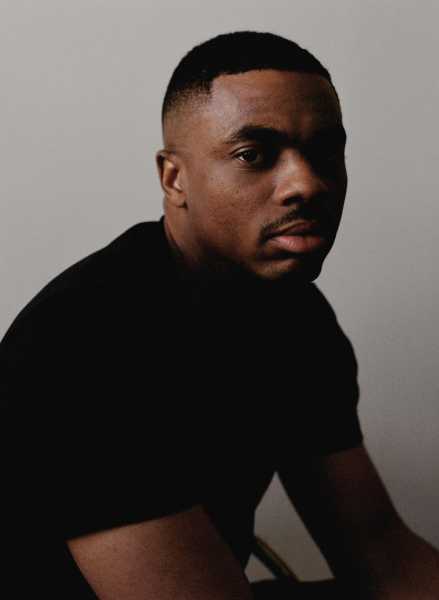
Photograph by Shaniqwa Jarvis
The Long Beach rapper Vince Staples has always been a bit of a casual comedian, but he made an official transition earlier this year with the surrealist Netflix satire “The Vince Staples Show.” The series, which follows a fictional version of its titular star, bears striking similarities to his best music—slightly off-kilter, ruthlessly caustic, employing sharp eyes and a piercing wit to survey the tragedies and absurdities of SoCal gang culture. His most recent album, “Dark Times,” balances dual roles as reticent observer and snarky hood celebrity, capping his thrilling run to becoming an unlikely leading man.—Sheldon Pearce (Terminal 5; Oct. 18.)
Classical
After a buzzing opening night complete with an indiscreet bait and switch—Josh Groban headlined after an ever-busy Cynthia Erivo had to withdraw—next up for the New York Philharmonic is a celebration of Afromodernism. The ensemble, led by the conductor Thomas Wilkins, spotlights works by Black artists, both current and antecedent, which explore facets of the African artistic diaspora. The program includes the New York première of Nathalie Joachim’s Freedom Movement-inspired cello concerto “Had to Be,” with the soloist Seth Parker Woods, as well as David Baker’s jazz-infused “Kosbro” (short for “Keep on steppin’, brothers”) and Carlos Simon’s “Four Black American Dances.” William Grant Still’s sweeping Symphony No. 4, “Autochthonous,” closes the show.—Jane Bua (David Geffen Hall; Oct. 17-18.)
Ballet
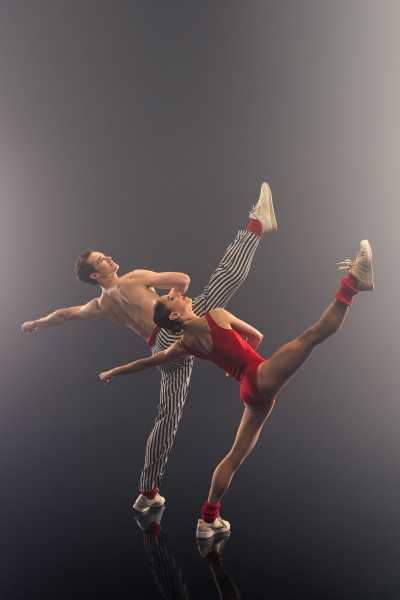
Cory Stearns and Skylar Brandt in “In the Upper Room.”
Photograph by Quinn Wharton
American Ballet Theatre’s fall season combines older works with something new: a full-evening story ballet based on—believe it or not—Fyodor Dostoyevsky’s “Crime and Punishment” (Oct. 30-Nov. 3). The choreographer, Helen Pickett, is a veteran of William Forsythe’s experimental troupe Ballett Frankfurt and of the Wooster Group. And from the archives, the company brings back the ethereal dream ballet from Petipa’s “La Bayadère,” known as the “Kingdom of the Shades,” first staged for the company fifty years ago, by the recently defected Russian ballerina Natalia Makarova (who will be honored on Oct. 23). The new ballets include premières by Gemma Bond and Kyle Abraham, and a quirky duet set to music for the shamisen (a Japanese banjo-like instrument) by Alexei Ratmansky.—Marina Harss (David H. Koch Theatre; Oct. 16-Nov. 3.)
Movies
In “Joker: Folie à Deux,” the director Todd Phillips’s overblown and undercooked musical sequel to “Joker,” the abused and aggrieved wannabe comedian Arthur Fleck (Joaquin Phoenix), following the first movie’s killing spree, is imprisoned in an asylum, where he falls for the patient Lee Quinzel (Lady Gaga). When Arthur stands trial for murder, his lawyer (Catherine Keener) portrays him as delusionally split into two personalities. Arthur denies this and wants to take responsibility for his crimes—but Lee is in love with his Joker persona. The idea is clever, even moving, but it remains undeveloped; instead, Phillips stages garish and clumsy production numbers, never lets Gaga cut loose vocally, pushes Phoenix through showy antics, and adds horrific brutality for shock value. The superb cast is left flailing in a void.—Richard Brody (In wide release.)

Pick Three
Hilton Als on a cluster of exciting downtown galleries.
On a little stretch of Henry Street near the Manhattan Bridge, several galleries have sprung up, reflecting their founders’ curiosity, taste, and commitment to showing work you wouldn’t find anywhere else.
1. At 56 Henry Street, the gallerist Eleanor Rines has put up early models constructed by the artist Laurie Simmons, which she used in photographs of pre-“Barbie” scenarios about gender and isolation. The models are brightly colored and viewed from above, like those one might see opening a science-fiction flick. But here the horror is quiet.

Photograph by Laurie Simmons / Courtesy the artist / 56 Henry
2. Down the street is the artist Jack Pierson’s Elliott Templeton Fine Arts, a jewel box of a space devoted to delicate ideas strongly executed. Up now are prints from a research project called “The Posture Study,” by the psychologist and eugenicist William H. Sheldon (1898-1977). The images show naked or semi-naked young men in a study that was conducted in higher education, where body shapes and presentation were thought to betray an aspect of character. Shot in black-and-white, the white men stare straight ahead, their faces blank of meaning while they’re being sized up, photographically speaking, to represent not a cross section of American life but its presumed center: the white male.
3. “We Can Grow or Wither,” the artist Josie Love Roebuck’s show at LatchKey Gallery, founded by the gallerist Amanda Uribe in 2018 to support emerging artists, celebrates the lives of women. Pieces made up of brightly colored fabric deal with the domestic, with portraiture, and with the artist’s joy in creating, all at once.
P.S. Good stuff on the Internet:
- In defense of fridgescaping
- New Bon Iver, just in time
- The case of Jack Nicholson’s missing baby teeth
Sourse: newyorker.com


